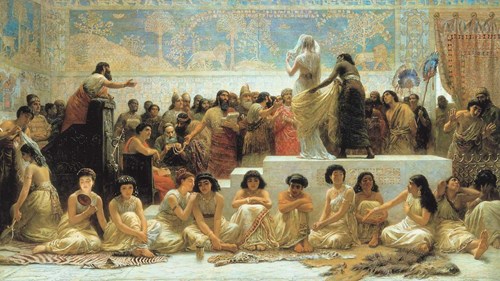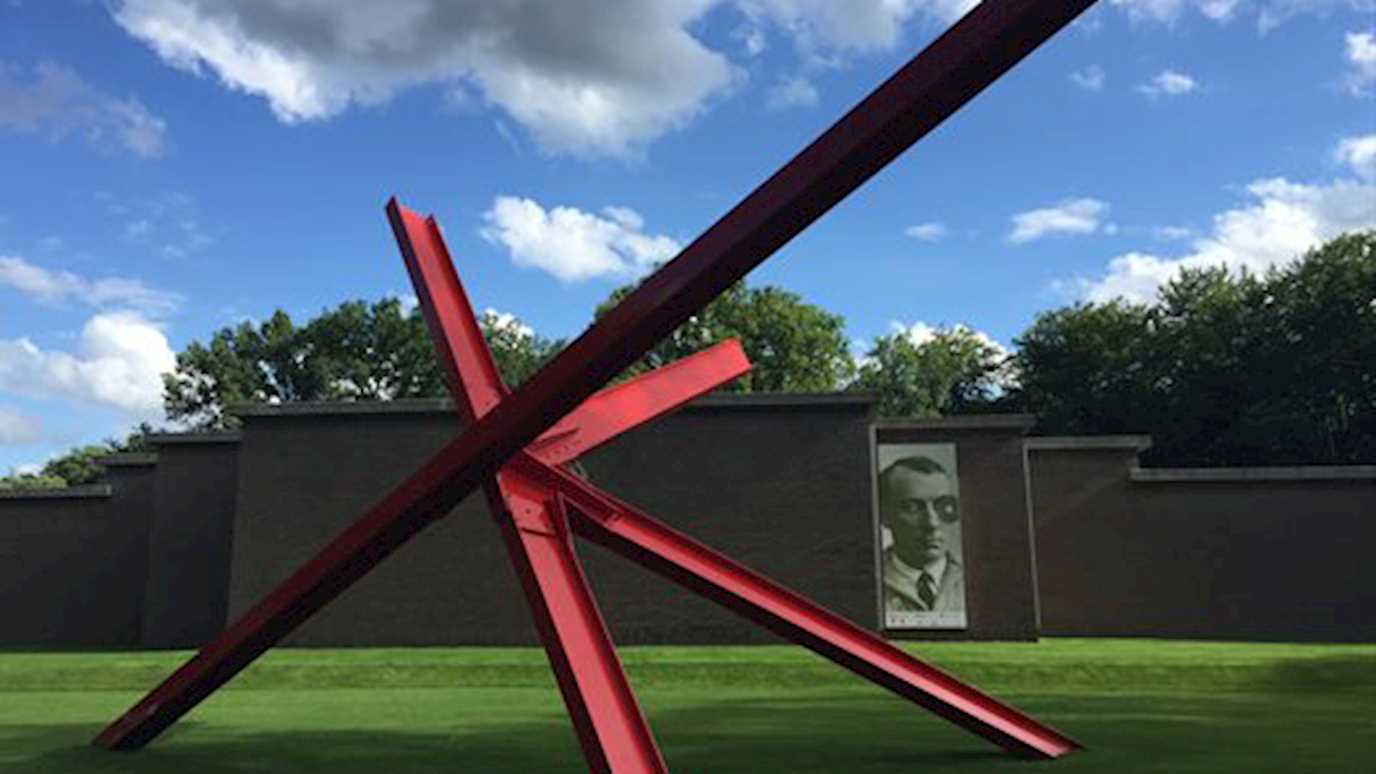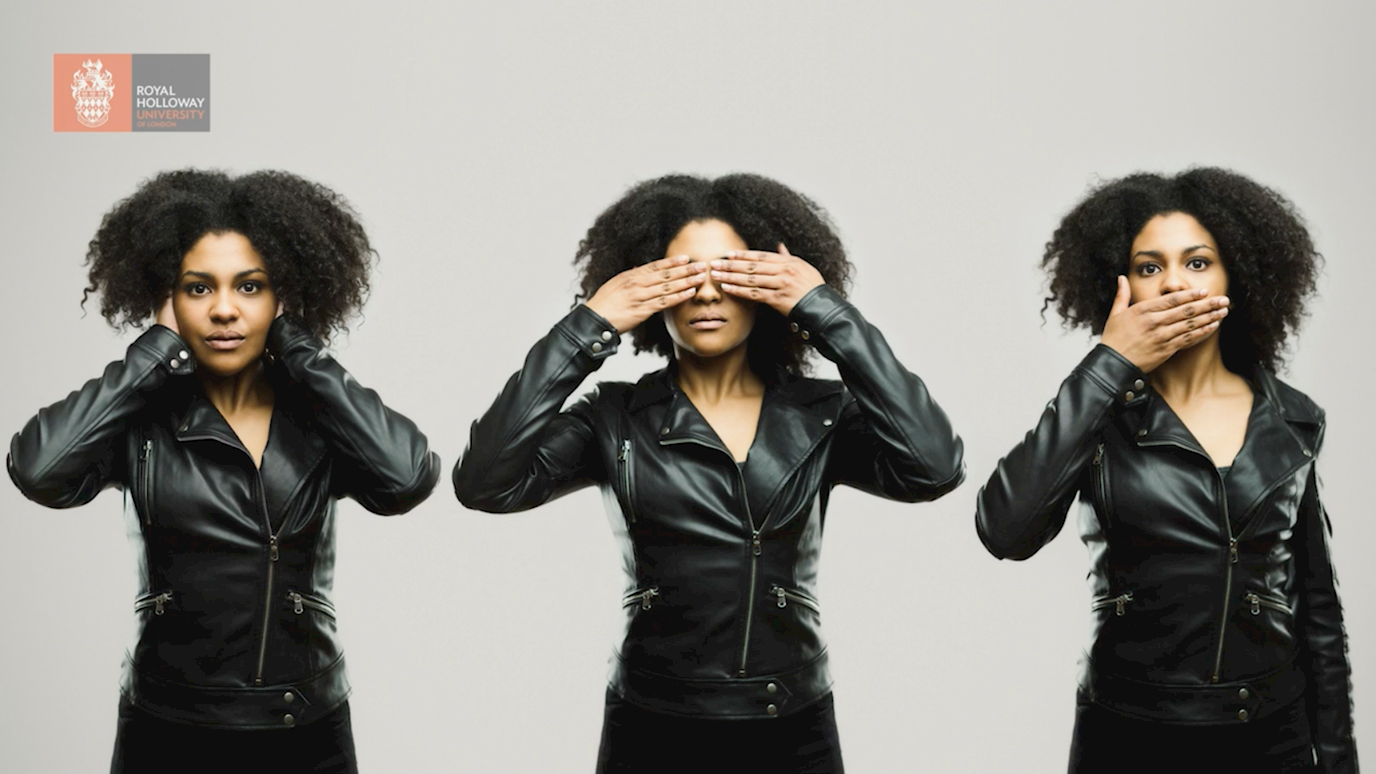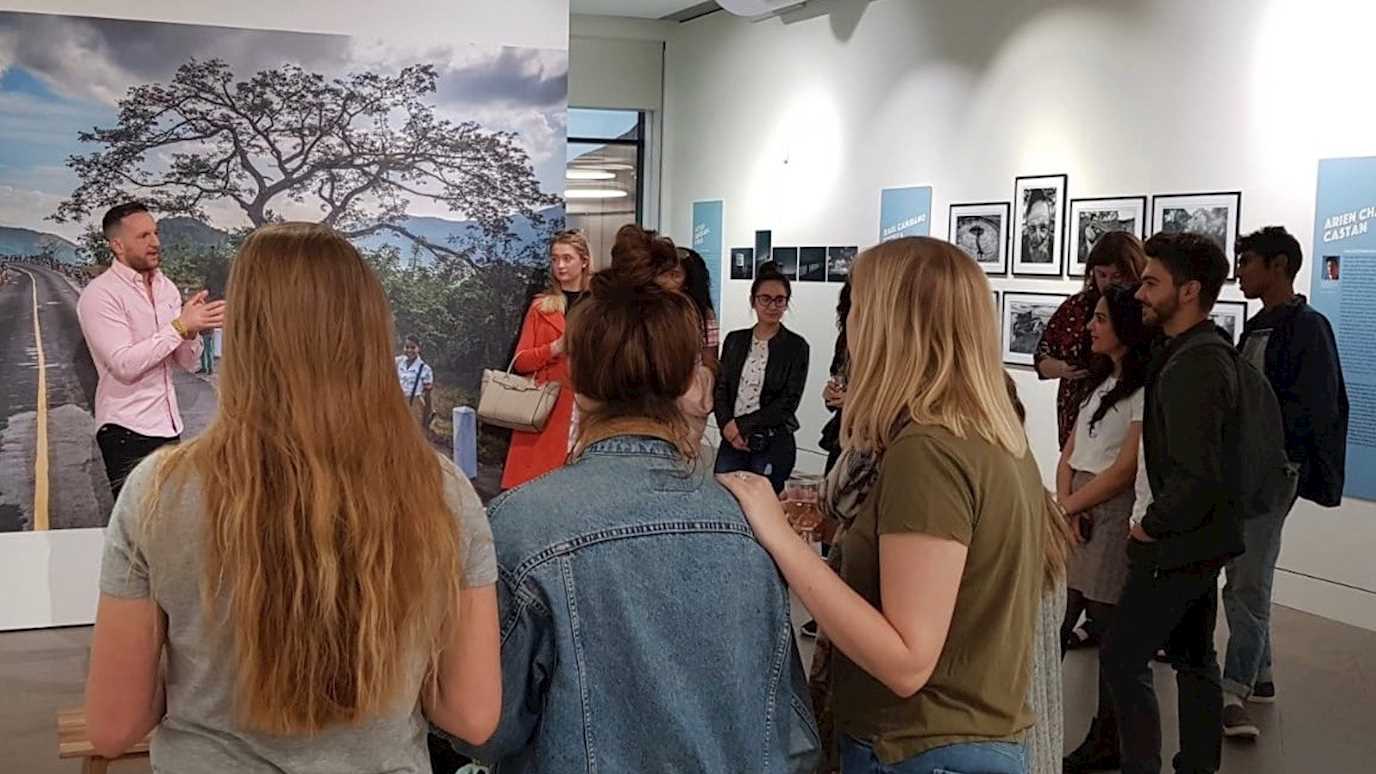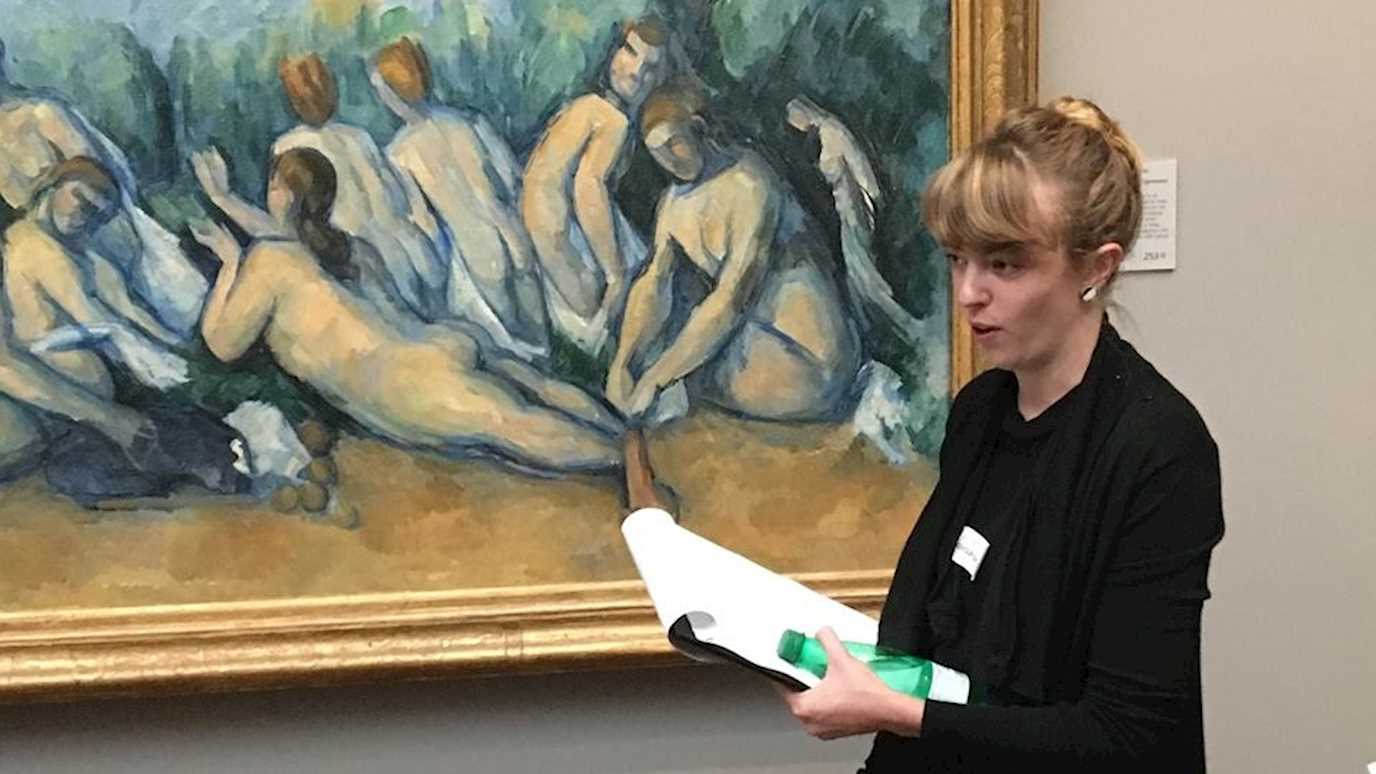Our members have participated in – and are currently involved with – a wide range of projects. Explore more about them here.
Main image shows a section of the cover from Dada’s Women by Ruth Hemus, artwork by Vaia Paziana.
The Sensational Museum
Prof. Hannah Thompson is the Principal Investigator at The Sensational Museum, an AHRC project to design and create sensory interventions that are accessible to all – using what we know about disability to change how museums work for everyone.
Find out more here
Words from the Wild: The Nature of Poetry
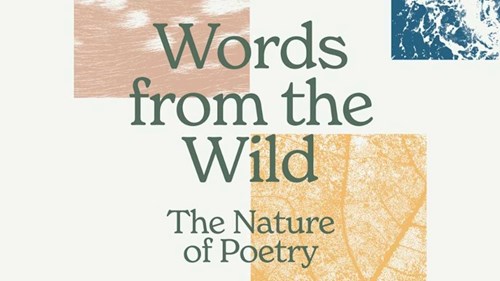
This exhibition, curated by doctoral researchers and CVC members Caroline Harris, Briony Hughes, and Gareth Hughes, runs from the 17th January - 24th March 2024 at the Emily Wilding Davison Building Exhibition Space.
Words from the Wild: The Nature of Poetry explores different forms of poetry, all of which respond to the natural world. The exhibition expands on what we might think of as a poem, to include films, textile banners, sculptures in beeswax, and prints made from 'listening' to trees. It brings together pieces by award-winning and internationally exhibited eco-poets and language artists, including J. R. Carpenter, Susan Johanknecht and Katharine Meynell, Camilla Nelson and Redell Olsen, along with works by an emerging new generation.
More information is available here
Textual Porosity: Exhibition
30 May - 11 June 2023

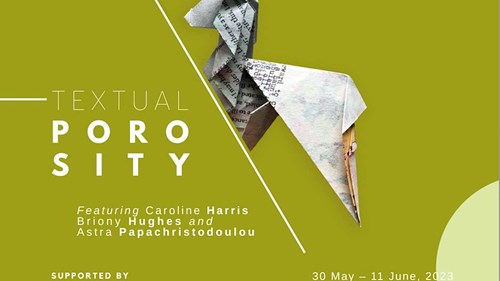
For the first time in Hampton Court village, Caroline Harris, Briony Hughes and Astra Papachristodoulou come together in a captivating group show that explores the tactility of language. The exhibition showcases innovative approaches to three-dimensional visual poetry and utilising found and ecological materials, and will be accompanied by a limited edition exhibition catalogue published by Poem Atlas. A celebratory launch event will take place on Friday 2nd June (6pm), and will feature readings from Caroline Harris, Briony Hughes and Astra Papachristodoulou. Free entrance for all.
The event has been made possible with the the kind support of the University of Surrey and Royal Holloway, University of London.
Image shows poster for Textual Porosity with an origami folded deer printed with text on lime graphic background.
The Language of Fake News: Conference
This hybrid event focussed on the linguistic evolution of fake news from the dawn of journalism to today. It offered insights on the dissemination and reception of fake news by addressing an important - yet overlooked - research question: what role does language play in the production and proliferation of fake news?

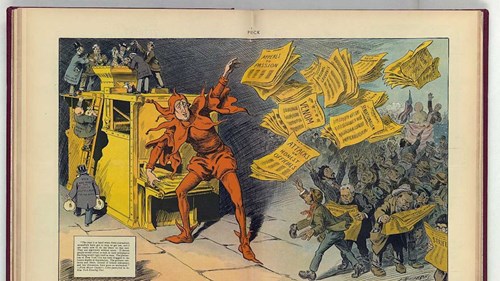 This conference was co-organised by Dr Carlotta Paltinieri and is partially funded by the Centre for Visual Cultures. For more information, see here.
This conference was co-organised by Dr Carlotta Paltinieri and is partially funded by the Centre for Visual Cultures. For more information, see here.
Image credit: N.Y. : Published by Keppler & Schwarzmann, Puck Building, 1910 October 12 via the Library of Congress. Image shows an illustration from the Yellow Press, depicting William Randolph Hearst as a jester tossing newspapers with headlines to a crowd of eager readers, among them an anarchist assassinating a politician speaking from a platform draped with American flags.
Engaged Visuality: Symposium
This is a symposium organized by Maria Elena Minuto (Université de Liège; KU Leuven) and Jan De Vree (M HKA Museum, Antwerp), and with CVC Member Giuliana Pieri on the Scientific Committee.
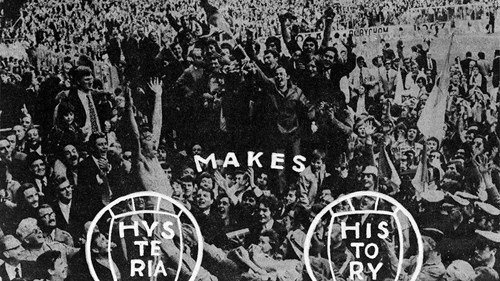
Engaged Visuality investigates the impact of new media, political imagery, and semiotics on poesia visiva phenomenon by focusing on a bilateral case study rarely analyzed from a comparative and transcultural perspective: the foundation of the international poetry magazine Lotta Poetica (first series: 1971-75) by Sarenco and Paul De Vree, i.e., the aim of Italian and Belgian interartistic exchanges, co-authored initiatives, and cross-disciplinary inquiries.
For more information, see here.
Image description and credit: A black and white photo of a crowd, with white overtype in capital letters saying 'Makes' and two circles underneath, one with the word 'Hys-te-ria' inside and one with the word 'His-to-ry'. Paul De Vree, Hysteria Makes History, 1973. Collection M HKA, Antwerp / Collection Flemish Community © M HKA
Kalila wa Dimna: Ancient Tales for Troubled Times
CVC member, Dr Rachel Scott, has collaborated on an art exhibition and public programme inspired by the global journeys of an ancient collection of moral fables across time and place, language, religion and culture.
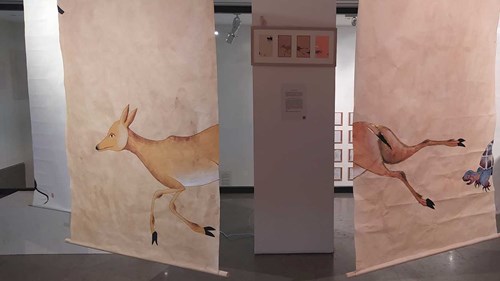
Kalila wa Dimna: Ancient Tales for Troubled Times approaches storytelling through various artistic mediums, aiming to widen access to and engagement with the arts within diverse and often marginalised communities while promoting cross-cultural understanding.
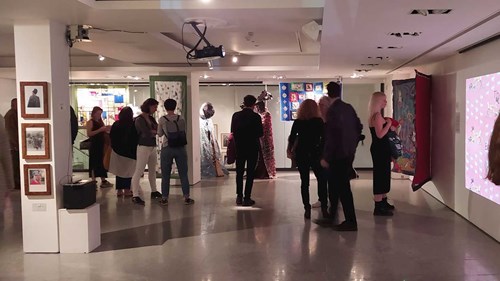
The exhibit and artistic program has developed out of the work of Language Acts and Worldmaking, a flagship project funded by the Arts and Humanities Research Council’s Open World Research Initiative. It is principally supported by The National Lottery Fund, Arts Council England and Language Acts and Worldmaking. The exhibition is hosted by the P21 Gallery.
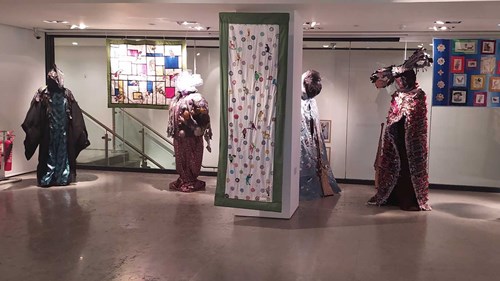
For more information and to book to attend workshops, talks and seminars, visit the project website: here.
Images inserted above show parts of the exhibition: the first shows a painting of a deer split over two panels with a pillar in-between, the second is from the opening night of the exhibit and shows people milling and looking at the artworks, the third depicts four mannequins wearing elegant textiled robes and hats.
Pregnant in a Pandemic
Pregnant in a Pandemic explores otherwise untold stories about the impact of the Covid-19 pandemic on pregnancy, birth and parenthood. Portraits of new and expectant parents living in London are accompanied by testimonies about love, loss and survival in the face of adversity. In this ongoing project, Dr James Kent is exploring themes such as community, place and space, and storytelling. The broader aim of the project is to connect communities, initiate conversations, and focus on the shared experiences that break down barriers and raise awareness about the challenges faced by families in a post-pandemic world.
Read more about the project: https://www.jckent.com/pregnant-in-a-pandemic/
Interdisciplinary Italy Phase 2, 1900-2020: Interart/Intermedia
Funded by an AHRC Standard Grant.
Principal Investigator: Clodagh Brook; Co-Investigators: Giuliana Pieri (Royal Holloway) and Florian Mussgnug (UCL).
Research Fellow: Emanuela Patti.
Project Partner: Estorick Collection of Modern Italian Art, London.
This project is founded upon work completed during the AHRC networking grant, Interdisciplinary Italy 1990-2015: Art, Music, Text. We thank all those who have supported us in that phase and helped us develop this second phase.
The context for this project
Since the start of the 20th century, the arts in Italy have rapidly developed hybrid forms. Cinema, digital visual poetry, sound art, filmed book trailers and other practices which cross arts and media and have become a major cultural force. Artists are shifting between different art forms with a fluidity which is striking: Dino Buzzati, for instance, writes novels, but also designs their illustrations; the poet Eduoardo Sanguineti traces his poetry back to atonal music. Until very recently this interartistic fluidity has been the prerogative of artists. Researchers worked against the grain of this cultural shift, analysing cultural products according to our own disciplines (literature, art, music etc.). In so doing, we risked overlooking a paradigm shift, losing hybrid art forms in the gaps between disciplines - where they receive only marginal treatment - and underestimating the value of one art for another.
As interdisciplinary methodologies develop, however, researchers now find themselves at a new historical vantage point. It is finally possible to build a groundbreaking interartistic perspective on the arts. The proposed project maps the paradigm shift in 20th and 21st century Italy. We also propose it as an intriguing case study for other language disciplines.
This project’s research questions
(1) Why has interartistic practice changed so markedly over the course of 20th and 21st century? Our project maps a fresh interartistic cultural history of Italy. It will answer questions like: Why did interartistic and intermedial practice occur in Italy at this time? What part do journals, cafés, printing, digital technology, and so on, play in development? Our response goes beyond the narrow focus of monodisciplinary research to reveal a more comprehensive picture of interartistic encounters and new kinds of experimentation. We challenge and amend established ideas of cultural centres and peripheries, to focus attention on individuals and groups who are actively engaged in creative boundary-crossing and on institutions who fostered or hindered interartistic exchange. Our project introduces a new and original focal point: we seek to examine how a multidisciplinary approach subverts widely accepted canons; what looks central under the lens of the monodisciplinary microscope may not be so from an interartistic one.
(2) Why have avant-garde and activist artists critiqued and transgressed the boundaries between the arts in 20th and 21st century Italy? What effect has this had on creativity? Since the beginning of the twentieth century, interartistic practice has been palpable in periods of uncertainty and radical social change, frequently associated with the avant-garde. It also appears to have emerged most strongly where political and cultural conventions are challenged, especially by activists. The first area our project explores is the transgressive nature of interartistic and intermedial creativity.
(3) What theories do we need to develop in order to discuss hybrid cultural objects and avant-garde interartistic practice? We will fashion a theoretical discourse to facilitate new research across the arts and media and underpin work done in our own project. This will highlight the social, creative and psychological dynamics of interartistic creativity, rather than the demands and constraints of disciplinary fields.
What we will be creating
What we will write over this period are two new interartistic cultural histories of 20th and 21st century Italy, one dedicated specifically to the digital age, a book providing a theoretical underpinning for interartistic research for a broader intellectual community and, of course, a series of articles. We will also be writing sample interartistic/intermedial teaching material for secondary schools and, together with the Estorick Collection, working on an interartistic exhibition and catalogue. We will be developing dedicated events for postgraduates and postdocs, academics, museum curators and school teachers.These are targeted at informing ideas about interartistic practice and empowering those cohorts to work, in a theoretically informed way, on interartistic practice.
Audio Description: The Art of Access
This project seeks to explore ways in which audio description (AD) can be integrated into artistic production in creative ways which benefit both blind and non-blind spectators, participants and visitors.
COVIDA: International online exhibition on COVID-19
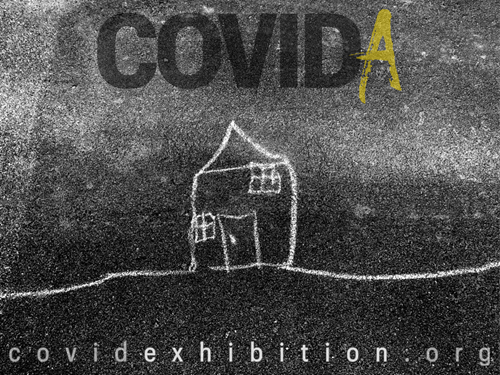
Exhibition website launches 1 August 2020.
Co-vi-da /ko ˈβida/ n [singular] cohabitation
With over two hundred images, a multimedia piece and aural testimonies, the Covida (covidexhibition.org) exhibition, co-organised by Miriam Haddu, Senior Lecturer in Mexican Visual Culture, encapsulates the meanings behind the pandemic that has struck the world this year. A collaborative online photographic exhibition dealing with COVID-19, Covida invites reflections on what it means to be human when our sensory world is obstructed. When we live and breathe behind masks. What happens to us when we are confined to remain indoors and away from loved ones? How does the alienation affect our senses, our minds, our worlds? How do our cities and landscapes look when we remove the human element? Is this a cleansing experience or the beginning of a degeneration? Covida brings together the vision, words and sounds from artists across continents, in a moment of remarkable challenge, to share in the common experience of being human as we reflect on our own vulnerabilities and strengths.
Francisco Mata Rosas is a renowned Mexican photographer, photojournalist, and professor at the UAM. Mata Rosas’s work has been published in many international media outlets, including The New York Times, The Los Angeles Times, La Jornada, Milenio, Reforma, The Independent Magazine, Photography (London), and El Paseante (Spain). For further details on his work see:
http://www.franciscomata.com.mx/ and https://youtu.be/MHSo3aPfhM8
Miriam Haddu is Senior Lecturer in Mexican Visual Culture in the Dept of Languages Literatures and Cultures, at RHUL. She is member of the School of Humanities’ Centre for Visual Cultures. Haddu has published extensively in the field, including on Mexican film, documentary and photography. She has curated photographic exhibitions in the UK and in the US. Links to her previous curatorial work can be found here: https://asuartmuseum.asu.edu/content/araceli-herrera-mexico-through-lens and https://www.newstatesman.com/node/160815
This event has received sponsorship from HARI (Humanities and Arts Research Institute) and the Dept of Languages, Literatures and Cultures (Humanities), for which the organisers are grateful.
Making Royal Holloway’s art collection more accessible
Professor Hannah Thompson, who describes herself as ‘partially blind’ and is an expert in audio description, has teamed up with the university’s art collections team to produce the first audio-described tour of paintings displayed in the famous Picture Gallery, on the campus in Egham.
Professor Thompson and Dr Laura MacCulloch, Curator at Royal Holloway, wanted to explore an innovative way of making the collection of works more accessible to everyone, and thus came up with the creative idea of using Professor Thompson’s theory of ‘blindness gain’. This research uses a crowd-sourced audio-description project with volunteers from across the university community who have been trained in the art of Creative Audio Description (CAD).
Now, thanks to museum and gallery app, Smartify, the audio-described tour is available online. The tour includes a short description by Hannah followed by creative audio descriptions of 15 paintings from the Picture Gallery, including old favourites such as ‘Man Disposes, God Proposes’ and ‘Princess Elizabeth in Prison at St James’. The descriptions are given by current Royal Holloway students and staff.
Making Space for Art
For as long as art has existed, so too has the question of where and how it is experienced.
Art institutions, from the major national collections to regional museums, and university galleries, play an important role in reflecting, and in shaping, cultural identity. The practice and the reception of art are constantly evolving, and so the role of curating has diversified to engage with the changing nature and growing diversity of artistic practices.
This seminar series, now in its fourth year, explores the relationship between curating, display, and space, and examines the ways in which different practices of curating can shape our understanding of physical as well as cultural environments. The invited speakers represent a wide cross-section of different types of art space with contrasting imperatives, objectives and priorities. Our aim and hope is that engaging in dialogue will help to generate debate on the myriad ways of shaping our encounters with art.
‘¡Yo soy Fidel!’: Post-Castro Cuba and the Cult of Personality
After the end of the Castro brothers’ near six decade-long leadership of Cuba in 2018, two years after Fidel Castro’s death, Dr James Kent's AHRC-funded project explored the presence of iconic revolutionary images in contemporary Cuban society and themes such as the relationship between photographic language and identity. Drawing on fieldwork and practice-led research, the accompanying exhibition included images taken by both Cuban and renowned foreign photographers. This project was fully funded by the AHRC as part of the Multilingualism: Empowering Individuals, Transforming Societies (MEITS) project based at the University of Cambridge.
Read more about the project: https://www.jckent.com/this-is-cuba
Dada’s Women
Collaborative mixed-media works based on Dada’s Women
This project is a collaboration by Sonia Allori, Ruth Hemus and Vaia Paziana. Our aim is to produce creative interpretations, multimedia performances and interactive workshops that draw on of some of the pioneering women who shaped the early twentieth-century Dada movement. Triggered by Ruth’s book Dada’s Women (Yale University Press, 2009) our project draws inspiration from Emmy Hennings, Sophie Taeuber, Hannah Höch, Suzanne Duchamp and Céline Arnauld. Original musical composition by Sonia Allori and visual artworks by Vaia Paziana mediate between creative and innovative women one hundred years apart. Accessibility is at the heart of our project.
Pilgrimage
Dr Arantza Mayo is currently working on a project which explores the art, literature, history, representation and impact of pilgrimage routes.
This includes the co-curation of a photographic exhibition (with Dr Harriet O’Neill, and sponsored by Xacobeo) on ‘Hospitality on the Pilgrim Road to Santiago de Compostela’ and a multidisciplinary symposium on ‘Sharing the Road: Real and Imagined Pilgrimages’.
Arp: The Poetry of Forms
Professor Eric Robertson co-curated the international exhibition ‘Arp: The Poetry of Forms’, which ran at the Kröller-Müller Museum from May-September 2017 and will run at Turner Contemporary from 13 October 2017 until 14 January 2018.
This will be the most important retrospective of Arp’s work in the UK for over half a century. In October 2017 Turner Contemporary will also host the world premiere of ‘Amphora’, an original score and performance inspired by Arp and written by composer Helen Caddick.
Laboratoire d'Europe: Strasbourg 1880-1930
Les Musées de la Ville de Strasbourg invited Eric Robertson to take part in two documentary films on the poets Hans Jean Arp and René Schickele, which will be screened as part of the exhibition Laboratoire d’Europe: Strasbourg 1880-1930 from September 2017 until February 2018.
Shoreditch Bridge Portraits 2011-2017
Dr James Kent has been working in collaboration with the photographer John Perivolaris on his series Shoreditch Bridge Portraits 2011-2017. The 300 images that comprise this series of photographs present a portrait of one location in a great city at a significant juncture in London’s history. Photographed under a concrete railway bridge in Shoreditch since 2011, the images that make up the series capture passers-by who are both anonymous and transient, in a fleeting moment as they move between places.
Interdisciplinary Italy 1900-2015
This international network received an AHRC networking grant (2012-14). It spans the US, UK and Italy and takes two complementary directions.
The first, its intellectual strand, explores issues arising from interdisciplinarity in the arts in 20th and 21st century Italy. It brings together academies, artists and museum curators. Notions of border-crossing, emancipation, transgression and fragmentation are applied to the relations between literature, music, cinema and the visual arts. This strand spans modernism, postmodernism and the internet age.
Aims
We aim to address questions such as where the roots of modern and contemporary interdisciplinarity lie, what contributed to these developments and what the place of technology, artistic milieu, cafés, internet etc. is in the development of cross-fertilisation? By bringing people together who may never have worked together before, alongside publications, we hope to create new debate and open a space for new projects and collaborations.
Our second direction
The project’s second direction is its policy strand. This involves Languages policy makers, academics and secondary school teachers discussing questions that have arisen from the intellectual strand. The latter strand will result in a searchable database of all UK professionals working in Italian culture (both inside and outside the academy) and publications. The idea is to explore interdisciplinarity in relation to how Italian Studies and Modern Languages are researched and taught in universities and the public engagement profile of our discipline.
Events
Three workshops and one panel will take place by the end of the project:
(1) ‘Italian interdisciplinary modernism’ (New York University on 22 February 2013)
(2) ‘Italian interdisciplinary avant-garde ’, (UCL, March 2013)
(3) ‘Contemporary Italian Interdisciplinarity in the Internet age’ (Roma Tre, April 2013)
(4) A panel at the SIS conference next summer, Interdisciplinarity and the Disciplines (July 2013).
The project website contains further information on the workshops, a blog, and brings together key ideas emerging from each of the websites and the panel.
For further information please contact Dr Giuliana Pieri.










